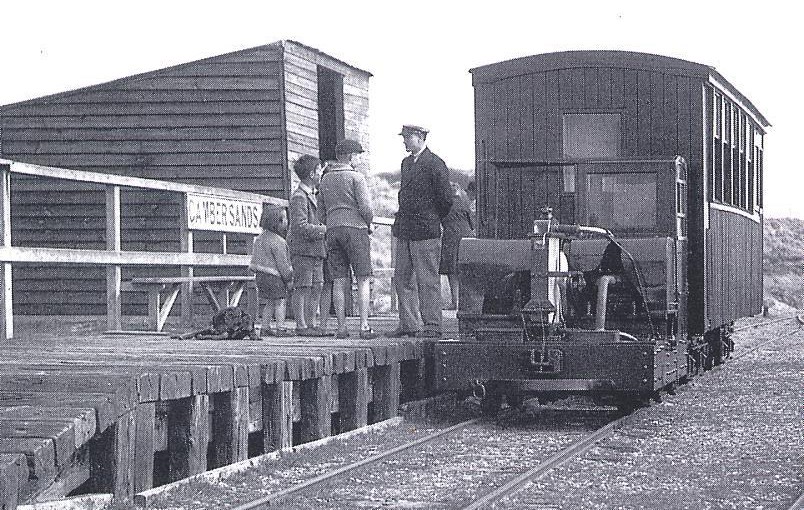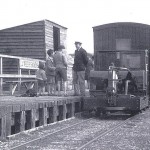What was Rye really like in the six or seven years prior to the War? It is after all less than 75 years ago.
To those in their fifties and sixties now there may be first hand accounts from their parents to remember and those in their eighties will have their own memories.
There was no Tilling Green Estate. Kings Avenue were the only ‘new’ council houses. The Ferry Road School was not opened until 1938, Rye children were educated at the Lion Street School, now the Further Education Centre and Library and at the Boys School in Mermaid Street, now the Boys Club.
German merchant ships were regularly seen at The Strand collecting scrap metal, material that they were to deliver back to us in 1940 in the form of high explosive bombs.
Trade was good in Rye, it was a Market Town serving all the surrounding villages. On market day s heep and cattle were driven through the streets to Rye Cattle Market where there were beef, sheep, pigs and poultry of all types for sale by auction. A special spur line allowed cattle and sheep to be brought right into the market by train.
The local shops were busy and prosperous in these years. Few people had cars, so going to Hastings was either by bus or train and usually a special and rare event. Most needs were catered for in Rye’s shops. There were a dozen or so grocery shops to choose from and at least three butchers. Produce was invariably local and fresh.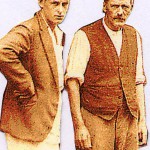
Below:- Jim (Jumbo) Hollands and his son Jim who ran a confectioners and Pastry business in Cinque Ports Street.
This was a time when few people locked their doors, there was little crime. What there was was dealt with by the Rye Police Force stationed at Church Square. Magistrates at the Town Hall administered swift justice to those who were bought before them.
Visitors came to Rye in some numbers, Rye has been a popular tourist attraction since Victorian times. The Pipemaker’s Arms boasted a magnificent arch at the Strand entrance to its car park and was often frequented by coach parties. Guest Houses and Hotels were full during the summer months and the Rye & Camber Tram was still puffing its way from Monkbretton Bridge to Camber Sands Station via The Golf Links Station.
There were two bus routes to Hastings. The ‘Red’ bus (East Kent) went by way of Winchelsea and Icklesham while the ‘Green’ bus (Maidstone & District) took a more circuitous journey via Brede and St Leonards.
Who were the characters of the time? Who made the town tick? Cartoonist ‘Baldwin’, who lived in Rye and later became famous for his work with a national newspaper, did a series of caricatures of the town’s leading lights. Many of these gentlemen left their mark on Rye to such a degree that we are still benefiting to this day.
William ‘Buck’ Ellis was a builder and later a Funeral Director. The business name ‘Ellis Brothers’ continues to the present time.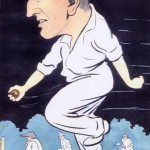
Wright & Pankhurst owned the Tower Street building that became Dean’s Rag Book factory and is now the Fish Restaurant. Wright & Pankhurst were one of the local Removal Companies. They also ran a bus service to Camber in direct competition with the Camber Tram in the 1920’s and early ’30’s.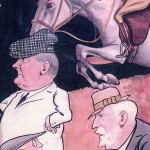
Major Hacking had a large farm and was very much involved with hunting and ‘Point to Point racing. He was also a member of the Cars parked on Camber Sands. 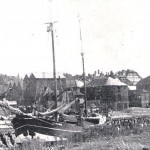
A German vessel ties up at The Strand waiting for a load of scrap metal to take back to Nazi Germany.
The Rye & Camber Tram at Camber Station.
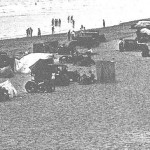
Lifeboat crew before the ill fated day in 1928 when the Lifeboat overturned and all seventeen crew were drowned . John Hacking failed to hear the maroon on that terrible, stormy morning, so did not gallop his horse cross country to the lifeboat house and take a place in the boat. He, by the grace of God, was able to enjoy the 1930’s and pursue his racing interests but in 1944 he was killed when a Flying Bomb exploded while he slept.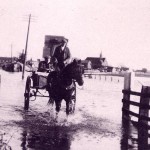
In 1932 Rye Harbour was flooded, many houses had to be evacuated, a second disaster for the small village which had suffered so much four years previously.
The floods at Rye Harbour in 1932
Throughout the thirties sport played a major part in Rye’s activities. Rye United became the best team in the area and at the local Rye Sports Days local cyclists and athletes carried off many of the prizes. The Bonfire Boys held their annual Rye Fawkes Night celebrations and in the summer there was a fine carnival to enjoy.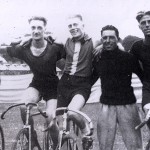
The Rye Wheelers Track Team of 1937
The standard of education and living accommodation was improving by leaps and bounds. The shops were full, visitors came to view the cobbled streets of the old town and marvel at the number of Tudor buildings. Then the War came and spoilt everything.
From “Rye’s Own “ January 2005
All articles, photographs and drawings on this web site are World Copyright Protected. No reproduction for publication without prior arrangement.
